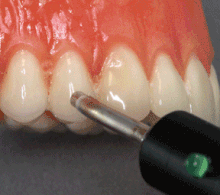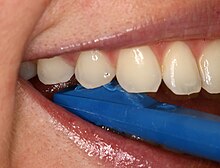Sensitivity Check

The sensitivity test (inaccurately also called vitality test ) is a routine, non-invasive examination method in pulp diagnostics . In dentistry, it describes a provocation test that examines the sensitivity of a tooth. It is one of the characteristics to determine whether a tooth is vital or dead ( devital ).
indication
The clarification of the vitality of a tooth is the most common indication of the sensitivity test, but the use of X-ray diagnostics is often necessary to substantiate the suspected diagnosis. If the sensitivity test of a diseased tooth is followed by a strongly delayed response, this is often interpreted as the residual vitality of an otherwise necrotic pulp. A faster response to the sensitivity test, for example compared to a healthy tooth, often indicates pulpitis . An excessively strong stimulus response can occur in teeth with dentin hypersensitivity (hypersensitivity), with wedge-shaped defects or exposed tooth necks and after root planing (periodontal treatment), as well as with carious defects or after conservative or restorative treatment of the same as postoperative hypersensitivity.
execution
The endings of nerve cells, whose cell bodies are concentrated in the ganglion of the trigeminal nerve , serve as thermal receptors . There are several methods available for examining the pulp of a tooth.
Thermal tests
Warm and cold receptors generate a certain, constant number of action potentials (impulses), the so-called spontaneous frequency, at a constant temperature. The receptors respond to a sudden change in temperature with a sudden, “excessive” change in the pulse frequency (dynamic frequency) up to a maximum or minimum value. The frequency then levels off to a new (higher or lower) value. Cold receptors react to a decrease in temperature with a sudden increase in frequency, to an increase, however, with a similar decrease. Warm receptors respond exactly the other way around. Temperature jumps of up to a few tenths of a degree are answered in each case. The greater the temperature jump and the faster it occurs, the stronger the dynamic response.
The sensation for a certain temperature gradually decreases, even if it remains objectively constant (sensory adaptation ). Although the receptors continue to transmit the “current temperature”, an adaptation to the stimulus takes place in the central nervous system . In the medium temperature range (between 20 and 40 ° C), cooling or warming only temporarily leads to a warm or cold sensation, after which the sensation is neutral (complete adaptation).
Cold test
A cold test can be carried out using CO 2 snow or aerosols. This nitrogen snow is filled into an application syringe from a storage pressure container before use. However, the cold source is usually a cold spray made of propane / butane , dichlorodifluoromethane (CFC) or chloroethane . In some cases, an aromatic substance is added to the refrigerant , for example peppermint . This creates a temperature of around −40 ° C. This is a pellet of foam , a cotton pellet or a cotton swab sprayed. It would not be possible to hit a tooth with one shot of spray from a can. The pellet is briefly held against the tooth and the patient can indicate whether and how strongly he feels the cold stimulus. In simple cases, a cold blast of air from the water-air gun of the treatment center is sufficient.
Heat test
For a heat test, gutta-percha is used, which is heated a little over a flame until it becomes soft. The gutta-percha point is briefly held against the tooth to be examined and the patient can indicate whether and how strongly he feels the heat stimulus. The temperature to which the material is heated is between 40 ° C and 45 ° C.
Electrical test
When testing sensitivity using electrical tests, a distinction is made between bipolar and unipolar procedures, i.e. between devices that supply increasing voltage or increasing current strength . What all electrical methods have in common is that the transmission of electrical energy directly stimulates the pulp nerves. Each tooth behaves like a capacitor , so that current can only flow when a certain "threshold voltage" is reached. To do this, the tooth is dried and the electrode is wetted with an electrically conductive medium, such as toothpaste . The electrode is held on the tooth surface of the tooth to be examined. The current intensity can be adjusted by means of a regulator. If the reaction is positive, the patient will feel a tingling sensation. The device should not be used on patients with pacemakers . False-positive reactions can occur with metal restorations, as well as with contact with a neighboring tooth.
In teeth that have just erupted, in which the growth in length of the root and the formation of the apex have not yet been completed and their Rashkov plexus is not yet fully developed, the sensitivity test for these teeth is often false negative.
The first perception on the sensitivity test may be a sensation below the pain threshold. This perception, known as “ pre-pain ” in the English-speaking world , often manifests itself as “tingling” or “knocking”. The origin of this “pre-pain” phenomenon has not yet been clearly clarified.
Percussion test
When using a percussion test (tapping test), an instrument, for example the back of a probe, is used to tap the tooth from the occlusal or buccal direction in order to check for hypersensitivity of the periodontium . Alternatively, a bite test can be performed in which the patient bites a hard object.
Interpretation of the sensitivity test
The result of the sensitivity test is uncertain and can only be interpreted taking into account further findings. An x-ray of the tooth is usually helpful in interpreting the vitality test. A false positive result is obtained if the tooth is sensitive to touch. He supposedly reacts to the cold stimulus, but the sensory pain is triggered by the touch. The temperature sensitivity of a tooth varies depending on the stage of a carious process.
Comparative tests on other teeth reveal the basic sensitivity of a patient's teeth. The sensations can then be compared with the tooth to be examined.
A root-filled and thus devitalized tooth naturally cannot show a positive reaction. A tooth that is only partially dead can show what is known as residual vitality. This means that, for example, the pulp in one or more root canals is still partially sensitive to thermal stimuli, but the pulp in another root canal is already viable.
If the x-ray shows that the root canal - which contains the pulp - is obliterated (closed) due to the formation of secondary dentin, a sensitivity test is unreliable. Sensitivity tests on crowned teeth are difficult to test. The gold alloy of the non-veneered crowns distributes the cold stimulus too quickly over an area that is too large. In the case of veneered crowns, the ceramic does not allow sufficient heat / cold conduction. Crowned teeth often contain large build-up fillings that provide additional insulation to the tooth. The formation of secondary dentine can decrease the sensitivity of a tooth . The secondary dentine forms at the boundary between tooth pulp ( pulp ) and dentine (dentin) and is isolated from temperature stimuli.
In the case of heavily abraded (chewed) teeth, the vitality test can be negative despite the vital pulp. This is due to newly formed secondary dentists and tertiary dentists.
In the case of an anterior tooth trauma, the sensitivity test can be negative immediately after the event. Tooth sensitivity often returns over the course of a few weeks.
Reward
According to the assessment standard for dental services , the sensitivity test (called vitality test there) is carried out according to BEMA no. 8 (ViPr) rated with 6 points (approx. € 5.40)
According to the official private fee schedule for dentists (GOZ), the service is based on the GOZ no. 0070 (also called vitality test there) is rewarded with € 6.46 when applying the 2.3-fold rate.
Individual evidence
- ^ AH Rowe, TR Pitt Ford: The assessment of pulpal vitality. In: International endodontic journal. Volume 23, Number 2, March 1990, pp. 77-83, ISSN 0143-2885 . PMID 2202687 .
- ↑ Thomas Weber: Memorix dentistry . Georg Thieme Verlag, 2010, ISBN 978-3-13-114373-0 , p. 111–.
- ↑ K. Schäfer, HA Braun, L. Kürten: Analysis of cold and warm receptor activity in vampire bats and mice. In: Pflüger's archive: European journal of physiology. Volume 412, Numbers 1-2, July 1988, pp 188-194, ISSN 0031-6768 . PMID 3174381 .
- ↑ Clifford J. Ruddle, Die thermoplastic 3-D Obturation ZWP-online. Retrieved October 4, 2014.
- ↑ AS Virtanen, T. Huopaniemi et al. a .: The effect of temporal parameters on subjective sensations evoked by electrical tooth stimulation. In: Pain. Volume 30, Number 3, September 1987, pp. 361-371, ISSN 0304-3959 . PMID 3670881 .
- ↑ a b R. Pileggi, TC Dumsha, NR Myslinksi: The reliability of electric pulp test after concussion injury. In: Endodontics & dental traumatology. Volume 12, Number 1, February 1996, pp. 16-19, ISSN 0109-2502 . PMID 8631284 .
- ^ AC Brown, WJ Beeler et al. a .: Spatial summation of pre-pain and pain in human teeth. In: Pain. Volume 21, Number 1, January 1985, pp. 1-16, ISSN 0304-3959 . PMID 3982834 .
- ↑ L. Müller, The Influence of Orthodontic Forces on Tooth Sensitivity , dissertation, Heinrich Heine University Düsseldorf, pages 16 to 19. Accessed on October 4, 2014
- ↑ Schedule of Fees for Dentists (GOZ) 2012, German Dental Association ( PDF; 3 MB). Retrieved October 5, 2014.



